
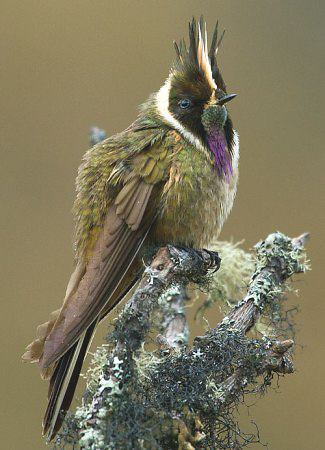
The endemic Buffy (Bearded) Helmetcrest in Los Nevados National Park (Nevado del Ruiz) by Ian Merrill.
- Birds, birds, birds, over 1900 species of them, more than any other country in the world
- Including over 90 endemic species
- With over 25 in the Santa Marta region alone, including White-tailed Starfrontlet, Blue-bearded Helmetcrest and Yellow-crowned Whitestart
- And many Choco endemics, the region covering far eastern Panama, western Colombia and western Ecuador which supports the largest number of restricted-range species of any Endemic Bird Area in the Americas, over 60 of them including the Colombian Choco endemics Black-and-gold, Gold-ringed and Multicoloured Tanagers
- As well as some of South America’s and the world’s most spectacular other birds, not least American Flamingo, Scarlet Ibis, Oilbird, quetzals, nearly 150 hummingbirds, motmots, toucans, Andean Cock-of-the-rock, many colourful tanagers and several species of habituated antpittas
- Hence it is possible to record over 700 species in three weeks, including over 50 endemics if the Santa Marta region is included, and, if Amazonia is added on to an itinerary, even an incredible 1000 species are possible in a month!
- There are a few mammals too, including White-footed Tamarin and Red Howler Monkey
- All because of the incredible habitat diversity that includes Caribbean and Pacific coastlines, part of the Llanos, the isolated Santa Marta Mountains, three forested Andean Cordilleras, and the lowland rainforests of the Amazon and Orinoco regions
- This account is about the northern and central Colombian Andes, a region of the country where many areas are now relatively safe to visit. Colombia as a whole is much safer to visit than it used to be and many tour companies now run organized tours here but there is still some conflict between government forces and guerrilla and paramilitary groups, and significant parts of the country are still not safe to visit. Some of these are in lowland Amazonia in the far southeast of the country although there are also safe areas here where there is a chance to experience a completely different but equally exciting avifauna to that in the Andes, including macaws, jacamars, antbirds and cotingas. Remaining forest patches in the Mitu area are particularly good, with birds such as Red-fan Parrot, Pavonine Quetzal, Black-eared Fairy, Fiery Topaz, the very rare Fiery-tailed Awlbill, Bronzy, Paradise and Yellow-billed Jacamars, Brown-banded and Spotted Puffbirds, Tawny-tufted Toucanet, Lemon-throated Barbet, Rusty-breasted Nunlet, Ringed Antpipit, many antbirds including the rare Yellow-throated Antwren, and Chestnut-crested and Grey-bellied Antbirds, Guianan Cock-of-the-rock, Pompadour, Purple-breasted and Spangled Cotingas, White-browed Purpletuft, Azure-naped Jay, Musician Wren, Plumbeous Euphonia and the rare White-bellied Dacnis.
- The combination of deserts, inland and coastal wetlands, lowland Amazonian rainforest, three Andean ranges, east-slope temperate forests, and the Pacific-coast forests of the Choco region, between the Caribbean and Amazonia in an area only slightly larger than that of Spain and France combined, supports a huge variety of birds, the most species for any country in the world in fact; 1965 in Birds of Colombia published by Lynx in early 2021, with 4 introduced species and 42 vagrants, but if all subspecies likely to be awarded species rank are accounted for, the number of possible species goes to over 2000, almost one-fifth of the world’s birds.
- So, on a month-long trip that includes the Andes, the Sierra Nevada de Santa Marta region in the north and the Mitu area (where there are about 300 different species to the other two regions) it is possible to record over a thousand species, as Rockjumper have on three occasions, including 2014 when they recorded an incredible 1044 species in 29 days in January-February! A list which included 63 endemics, 36 parrots, 9 owls, 11 nightjars, 86 hummingbirds, 10 trogons, 15 puffbirds, 16 toucans, 27 woodpeckers, 60 antbirds, 14 antpittas, 14 cotingas, 12 manakins and 113 tanagers and allies.
- Also in eastern Colombia, in the Llanos region, accessible from places such as Juan Solito Lodge, a long drive and boat ride east from Yopal which is accessible by air from Bogota, it is possible to see the likes of Crestless Curassow, Orinoco Goose, Horned Screamer, Capped Heron, Buff-necked, Scarlet and Sharp-tailed Ibises, Jabiru, King Vulture, Aplomado Falcon, Azure Gallinule, Sunbittern (Ariporo River), Hoatzin, Nacunda Nighthawk, Pale-headed Jacamar, Russet-throated (Double-banded) Puffbird, Rusty-backed Spinetail, White-bearded Flycatcher and Violaceous Jay, as well as Red Howler Monkey, Capybara and Spectacled Caiman. In the San Jose del Guaviare region where the Llanos meets Amazon rainforest White-eared Jacamar, Brown Nunlet, Cream-colored Woodpecker, Long-billed Woodcreeper, White-shouldered Antbird, Pink-throated Becard and Bare-necked Fruitcrow occur at Playa Guio, and Agami Heron, Swallow-winged Puffbird, Black-fronted Nunbird and Velvet-fronted Grackle at Buenavista. Based at Inirida at the confluence of the Inirida and Guaviare rivers it is possible to see Orinoco Piculet and Orinoco Softtail, as well as Ruby Topaz, Long-billed Woodcreeper, Capuchinbird, Purple-breasted and Spangled Cotingas, White-browed Purpletuft, Azure-naped Jay and Orinoco River Dolphin (Boto). Other mammals in the San Jose del Guaviare area include Golden-backed (Black) Uakari, Mottle-faced Tamarin (Diablito), Black (Collared) Titi and Common (Brown) Woolly Monkey, while on boat trips along the Rio Guayabero at Remolino Los Dorados there is a small chance of White-fronted Spider Monkey and a better chance for Orinoco River Dolphin (Boto). Mammal watchers also head for Villavicencio, 75 miles southeast of Bogota, where it is possible to see Ornate Titi and Brumback’s (Lemurine) Night Monkey, as well as Brazilian Porcupine and Giant Anteater. November is normally the best time to visit the Llanos. By January it is usually very hot and dry.
- In the extreme south there are yet more special birds and very few people looking at them. About 450 species have been recorded along the old Buenaventura Road which descends from the western Andes to the Pacific Ocean along the Rio Anchicaya Valley along the edge of Farallones National Park including Long-wattled Umbrellabird and many tanagers. At Reserva La Isla Escondida there are two canopy towers and birds such as Nocturnal Curassow, Band-bellied Owl, Pavonine Quetzal, White-lored Antpitta, Rusty-belted Tapaculo, Amazonian Umbrellabird, Fiery-throated Fruiteater, Grey-tailed Piha and Yellow-lored Tanager. Up on the Páramo Quilinsayaco ó Bordoncillo are Noble Snipe, Rainbow-bearded Thornbill, Chestnut-bellied Cotinga and Masked Mountain Tanager. The rare Hoary Puffleg occurs in the Reserva Natural La Planada and the even rarer Colourful Puffleg in Munchique National Natural Park. One of the hummingbirds in Reserva Natural Rio Nambi is the more widespread but still little-known Rufous-gaped Hillstar. Also present in this reserve are Cloudforest Pygmy-owl, Long-wattled Umbrellabird, Choco Vireo, Choco Warbler and Moss-backed Tanager. Finally, there is another reserve at the Laguna de Sonso where Horned Screamer, Ruby Topaz, Greyish Piculet and Apical Flycatcher occur.
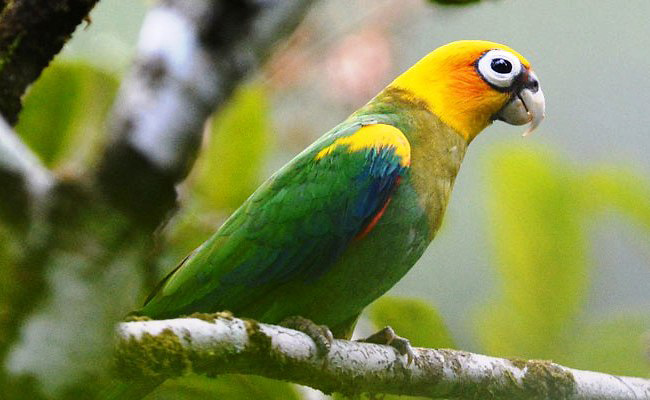
Saffron-headed Parrot at Rio Claro by Paul Noakes.
Best Birds and other wildlife in Colombia
Birds
Endemics 93 (including 25 in Santa Marta Mountains) (Of the 93; 18 hummingbirds, five antpittas, seven wrens and eight tanagers) Cauca Guan, Chestnut-winged Chachalaca, Colombian Chachalaca, Blue-billed Curassow, Chestnut Wood-quail, Gorgeted Wood-quail, Tolima Dove, Green-bearded Helmetcrest, Buffy Helmetcrest, Gorgeted Puffleg (Serrania del Pinche, southwest), Colourful Puffleg, Black Inca, Glittering (Dusky) Starfrontlet, Golden-bellied Starfrontlet, Chiribiquete Emerald (south), Tolima Blossomcrown, Chestnut-bellied Hummingbird, Indigo-capped Hummingbird, Sapphire-bellied Hummingbird, Bogota Rail, Sooty-capped Puffbird, White-mantled Barbet, Greyish Piculet, Beautiful Woodpecker, Rufous-fronted Parakeet, Indigo-winged Parrot (tiny range on west slope of central Andes), Turquoise-winged (Green-rumped) Parrotlet, Sinu (Painted) Parakeet (possibly extinct), Upper Magdalena (Maroon-tailed) Parakeet, Brown-breasted Parakeet, Yellow-eared Parrot (probably extinct in Ecuador), Parker’s Antbird, East Andean (Klage's) Antbird, Cundinamarca Antpitta, Northern Tawny Antpitta, Urrao (Fenwick's) Antpitta, Brown-banded Antpitta, Magdalena Tapaculo (two tiny areas, in north and south), Stiles’s Tapaculo, Tatama (Alto de Pisones) Tapaculo, Paramillo Tapaculo, Silvery-throated Spinetail, Chestnut-capped Piha (tiny range in central Andes), Antioquia Bristle-tyrant, Apical Flycatcher, Apolinar’s Wren, Colombian (Speckle-breasted) Wren, Antioquia Wren, Niceforo’s Wren, Munchique Wood-wren, Velvet-fronted Euphonia, Moustached Brush-finch, Yellow-headed Brush-finch, Dusky-headed Brush-finch, Antioquia Brush-finch (tiny range), Baudo Oropendola, Bronze-brown (Bronzed) Cowbird, Red-bellied Grackle, Mountain Grackle, Golden-fronted Whitestart, Sooty Ant-tanager, Crested Ant-tanager, Turquoise Dacnis, Flame-rumped Tanager, Chestnut-bellied Flowerpiercer, Multicoloured Tanager, Gold-ringed Tanager and Black-and-gold Tanager.
(Bogota Sunangel (Nehrkorn's Sylph) may still exist - a 'blue sylph' was seen at Rogitama in the mid 2000s, and Chami (Rufous) Antpitta is recognized as a separate species by some taxonomists)
Santa Marta Mountains 25 Black-backed Thornbill, Blue-bearded Helmetcrest, White-tailed Starfrontlet, Santa Marta Blossomcrown, Santa Marta Sabrewing, Santa Marta Woodstar, Santa Marta Screech-owl, Santa Marta Parakeet, Santa Marta (Long-tailed) Antbird, Santa Marta Antpitta, Santa Marta Tapaculo, Brown-rumped Tapaculo, Santa Marta (Ruddy) Foliage-gleaner, Rusty-headed Spinetail, Coopman’s (Golden-faced) Tyrannulet, Santa Marta Bush-tyrant, Santa Marta Wren, Hermit (Grey-breasted) Wood-wren, Sierra Nevada (Bangs's/Colombian) Brush-finch, Santa Marta Brush-finch, Santa Marta Warbler, White-lored Warbler, Yellow-crowned Whitestart, Carriker’s (Buff-breasted) Mountain-tanager and Santa Marta (Black-cheeked) Mountain-tanager.
Near-endemics
Colombia and Venezuela 81 (16 hummingbirds, three puffbirds and three antpittas) Rufous-vented Chachalaca, Yellow-knobbed Curassow, Helmeted Curassow, Black-fronted Wood-quail, Northern Screamer, Bare-eyed Pigeon, Pygmy Swift, Orange-throated Sunangel, Longuemare’s (Amethyst-throated) Sunangel, Perija Metaltail, Coppery-bellied Puffleg, Green (Collared) Inca, Perija (Golden-bellied) Starfrontlet, Blue-throated Starfrontlet, Red-billed Emerald, Coppery Emerald, Narrow-tailed Emerald, Short-tailed Emerald, Buffy Hummingbird, Steely-vented Hummingbird, Green-bellied Hummingbird, Shining-green Hummingbird, Violet-chested Hummingbird, Dwarf Cuckoo, White-tipped Quetzal, Pale-headed Jacamar, Russet-throated Puffbird, Two-banded (Russet-throated) Puffbird, Moustached Puffbird, Citron-throated (Channel-billed) Toucan, Yellow-billed (Groove-billed) Toucanet, Scaled Piculet, Chestnut Piculet, Rusty-faced Parrot, Perija (Painted) Parakeet, Scarlet-fronted Parakeet, Recurve-billed Bushbird, Streak-fronted (Black-crested) Antshrike, Bar-crested Antshrike, Black-backed Antshrike, Klages’s Antbird, Magdalena Antbird, Blue-lored Antbird, Perija (Rufous) Antpitta, Hooded Antpitta, Rusty-breasted Antpitta, Perija Tapaculo, Pale-bellied Tapaculo, Scalloped (Schwartz’s) Antthrush, Eastern Barred Woodcreeper, Caribbean (Pale-legged) Hornero, Plain (Rufous-fronted) Thornbird, Perija Thistletail, Streak-capped Spinetail, Crested Spinetail, White-whiskered Spinetail, Orinoco Spinetail, White-bibbed Manakin, Golden-breasted Fruiteater, Mountain (Spectacled) Tyrannulet, Slender-billed Tyrannulet, White-bearded Flycatcher, Scrub Greenlet, Black-collared Jay, Stripe-backed Wren, Black-billed Thrush, Tocuyo Sparrow, Perija Brush-finch, Yellow-mandibled (Pectoral) Sparrow, Golden-winged Sparrow, Ochre-breasted Brush-finch, Black-fronted (Yellow-breasted) Brush-finch, Grey-throated Warbler, Yellow-crowned (Golden-crowned) Warbler, Yellow-fronted Whitestart, Vermilion Cardinal, Orinocan Saltator, Fulvous-headed Tanager, Rufous-browed Conebill, Glaucous Tanager and Black-headed (Hooded) Tanager.
Colombia, Venezuela, and Trinidad & Tobago 6 Rufous-shafted Woodstar, Stripe-breasted Spinetail, Venezuelan Flycatcher, Trinidad Euphonia, Venezuelan Troupial and Masked Cardinal.
Colombia, Venezuela and Guyana 2 Northern Festive Parrot and Red Siskin.
Colombia, Venezuela and Guianas 1 Lilac-tailed Parrotlet.
Colombia, Venezuela and Brazil 7 Orinoco Piculet, Yapacana Antbird, Grey-bellied Antbird, Yellow-throated Antwren, Brown-headed Greenlet, Azure-naped Jay and Rio Negro Gnatcatcher.
Colombia and Brazil 1 Chestnut-crested Antbird.
Colombia, Brazil and Peru 2 Plain-breasted Piculet and Varzea Thrush.
Colombia and Ecuador 100 (20 hummingbirds, five antpittas, an umbrellabird and 13 tanagers) Berlepsch’s Tinamou, Baudo Guan, Rufous-fronted Wood-quail, Dark-backed Wood-quail, Dusky Pigeon, Purple Quail-dove, Choco Poorwill, White-whiskered Hermit, Western Wedge-billed Hummingbird, Gorgeted Sunangel, Tourmaline Sunangel, Violet-tailed Sylph, Ecuadorian Hillstar, Viridian Metaltail, Hoary Puffleg, Black-thighed Puffleg, Sapphire-vented Puffleg, Golden-breasted Puffleg, Brown Inca, Velvet-purple Coronet, Rufous-gaped Hillstar, Purple-bibbed Whitetip, Pink-throated Brilliant, Empress Brilliant, Western Emerald, Purple-chested Hummingbird, Gray’s Hummingbird (Blue-headed Sapphire), Banded Ground-cuckoo, Brown Wood-rail, Cloudforest Pygmy-owl, Colombian (Rufescent) Screech-owl, Choco Trogon, Choco Toucan, Plate-billed Mountain-toucan, Orange-fronted Barbet, Five-coloured Barbet, Toucan Barbet, Lita Woodpecker, Choco Woodpecker, Plumbeous Forest-falcon, Carunculated Caracara, Rose-faced Parrot, Choco (Maroon-tailed) Parakeet, Cocha Antshrike, Stub-tailed Antbird, Esmeraldas Antbird, Rufous-crowned Pittasoma, Giant Antpitta, Moustached Antpitta, Bicoloured Antpitta, Yellow-breasted Antpitta, Crescent-faced Antpitta, Narino Tapaculo, Spillmann’s Tapaculo, Pacific Tuftedcheek, Stout-billed Cinclodes, Uniform Treehunter, Fulvous-dotted Treerunner, Club-winged Manakin, Yellow-headed Manakin, Orange-breasted Fruiteater, Chestnut-bellied Cotinga (likely to occur in north Peru), Long-wattled Umbrellabird, Pacific Flatbill, Northern Ornate Flycatcher, Choco Tyrannulet, Coopmans’s Elaenia, Plain-capped Ground-tyrant, Black-billed Peppershrike, Pale-legged (Slaty-capped) Shrike-vireo, Choco Vireo, Beautiful Jay, Quindio (Black-collared) Jay, Black Solitaire, Chestnut-throated (Rufous-brown) Solitaire, Tanager Finch, Dusky Bush-tanager, Choco (Tricoloured) Brush-finch, White-rimmed Brush-finch, Olive-crowned Yellowthroat, Choco (Golden-bellied) Warbler, Ochre-breasted Tanager, Scarlet-and-white Tanager, Scarlet-breasted Dacnis, Yellow-tufted (Black-faced) Dacnis, Black-winged Saltator, Western Black-eared Hemispingus, Stolzmann’s Tanager (Black-backed Bush Tanager), Ochraceous (Cinereous) Conebill, Indigo Flowerpiercer, Purplish-mantled Tanager, Black-chinned Mountain-tanager, Glistening-green Tanager, Yellow-green Tanager (Chlorospingus), Moss-backed Tanager, Golden-chested Tanager, Rufous-throated Tanager, Scrub Tanager, Yellow-faced (Flame-faced) Tanager and Blue-whiskered Tanager.
Colombia, Ecuador and Peru 38 Pallid Dove, Ecuadorian Piedtail, Rainbow-bearded Thornbill, Buff-winged Starfrontlet, Chestnut-breasted Coronet, Green-backed (White-tailed) Hillstar, Rufous-vented Whitetip, Cinnamon Screech-owl, Coppery-chested Jacamar, Brown Nunlet, Guayaquil Woodpecker, Scarlet-backed Woodpecker, Pacific Parrotlet, Yasuni Stipplethroat (Antwren), Chestnut-naped Antpitta, White-bellied Antpitta, Western Tawny Antpitta, Long-tailed Tapaculo, Paramo Tapaculo, Pacific Hornero, Spectacled Prickletail, Grey-tailed Piha, Dusky Piha, Foothill Schiffornis, Ecuadorian Tyrannulet, Orange-eyed Flatbill (Flycatcher), Ochraceous Attila, Snowy-throated Kingbird, Mouse-grey (Bran-coloured) Flycatcher, Turquoise Jay, Plain-tailed Wren, Orange-crowned Euphonia, Ecuadorian Cacique, Scrub Blackbird, Ecuadorian (Blue) Seedeater, Masked Saltator, Masked Mountain-tanager and Golden-naped Tanager.
Others
The very long list includes guans, Northern Screamer, Torrent Duck, American Flamingo, Scarlet Ibis, Magnificent Frigatebird, many raptors including King
Vulture and Aplomado Falcon, Wattled Jacana, Noble Snipe, pigeons, doves, parakeets, parrots, Oilbird, many hummingbirds (many at feeders), Golden-headed
Quetzal, trogons, motmots, Rufous-tailed Jacamar, puffbirds, Red-headed Barbet, Chestnut-mandibled, Citron-throated and Keel-billed Toucans, Black-billed
and Grey-breasted Mountain-toucans, woodpeckers, foliage-gleaners, spinetails, woodcreepers, antshrikes, antwrens, antbirds, antpittas (several at
worm-feeders), tapaculos including Ocellated, tyrannulets, pygmy tyrants such as Rufous-headed and Black-capped (the smallest passerine in the world along
with Short-tailed Pygmy Tyrant), tody tyrants, tody flycatchers, flycatchers, Chestnut-crowned Gnateater, Andean Cock-of-the-rock, Dusky and Olivaceous
Pihas, fruiteaters including Golden-breasted and Scaled, Chestnut-crested Cotinga, Red-ruffed Fruitcrow, manakins including Golden-winged, Lance-tailed and
White-bearded, becards, tityras, Yellow-browed Shrike-vireo, wrens, Long-billed Gnatwren, White-capped Dipper, wintering warblers such as Blackburnian,
Cerulean and Prothonotary, conebills, hemispinguses, mountain tanagers, numerous tanagers including Flame-faced, Golden, Golden-crowned, Grass-green,
Red-hooded and White-capped, Rosy Thrush Tanager, dacnises, honeycreepers, Plushcap, flowerpiercers, brush finches, orioles, oropendolas, Chestnut-breasted
Chlorophonia and euphonias. Also a chance of wood quails, Blue-and-yellow and Chestnut-fronted Macaws, Lanceolated Monklet, Black-capped Donacobius and
Sapayoa.
Mammals
Endemics
Cotton-top and Silvery-brown Bare-faced Tamarins, Caqueta, Colombian Black-handed and Ornate Titis, Brumback’s (Lemurine) Night Monkey, Colombian Woolly
Monkey and Varied White-fronted Capuchin.
Near-endemics
Variegated (Brown) Spider Monkey and Grey-handed Night Monkey.
Others
Pygmy Marmoset, Cotton-top, Geoffroy's, Lesson’s Saddle-back, Mottle-faced (Diablito) and White-footed Tamarins, Golden-backed (Black) Uakari, Black-handed
(Medem’s/Collared) and Lucifer (Yellow-handed/Collared) Titis (and hybrids), Colombian (Venezuelan) Red Howler, Common (Brown) Woolly Monkey, Spix’s
(Noisy) Night Monkey, Brown (Tufted) and White-throated (White-faced) Capuchins, Common Squirrel Monkey (albigena and macrocephalus
subspecies), White-bellied and White-fronted Spider Monkeys, Orinoco River Dolphin (Boto), Brazilian Porcupine, Giant Anteater, Brown-throated Three-toed
Sloth and Western (Brown-eared) Woolly Opossum.
Invertebrates
The fantastic variety of butterflies includes clearwings, crackers, heliconids, morphos and satyrs.
Best Sites for Birds and other wildlife in Colombia
- North
- Sierra Nevada de Santa Marta NNP and Minca area including San Lorenzo Ridge Black-fronted Wood-quail, Band-tailed Guan, Lined Quail-dove, SM Parakeet, SM Screech-owl, White-tipped Quetzal, SM Blossomcrown, SM Woodstar, White-tailed Starfrontlet, Black-backed Thornbill, Coppery Emerald, Rusty-headed and Streak-capped Spinetails, SM Foliage-gleaner, Black-backed Antshrike (downhill from Minca), SM Antbird, Sierra Nevada (Rufous) Antpitta, Brown-rumped and SM Tapaculos, SM Bush Tyrant, Golden-breasted Fruiteater, Black-chested Jay, SM Wood Wren, Yellow-crowned Whitestart, White-lored Warbler, SM Mountain-tanager, SM and Sierra Nevada Brush-finches, as well as Black-and-white Owl, Common Potoo, Lazuline Sabrewing, Whooping Motmot, Keel-billed Toucan, Groove-billed Toucanet, Grey-throated Leaftosser, Rusty-breasted Antpitta, Black-throated Tody-tyrant, Paltry Tyrannulet, Lance-tailed Manakin, Orange-billed and Slaty-backed Nightingale-thrushes, Rosy Thrush-tanager, Plushcap and Golden-winged Sparrow.
- Isla de Salamanca RP Sapphire-bellied Hummingbird, as well as White-cheeked Pintail, Chestnut-winged Chachalaca, Sapphire-throated Hummingbird, Russet-throated Puffbird, Chestnut Piculet, Panama Flycatcher and Bicoloured Conebill.
- Parque Tayrona Cotton-top Tamarin.
- La Guajira Peninsula including Camarones and Los Flamencos Sanctuary Crested Bobwhite, Rufous-vented Chachalaca, Bare-eyed Pigeon, Green-rumped Parrotlet, Todd's Nightjar, Buffy and Shining Green Hummingbirds, Russet-throated Puffbird, Chestnut Piculet, White-whiskered Spinetail, Pale-tipped and Slender-billed Inezias, Northern Scrub Flycatcher, Orinocan Saltator, Vermillion Cardinal, Glaucous Tanager, Tocuyo Sparrow and Bronzed Cowbird, as well as American Flamingo, Scarlet Ibis and Lance-tailed Manakin.
- Las Lagunas de Santa Marta, a two day trek up from the town of San Pedro Blue-bearded Helmetcrest and Santa Marta Wren, two high-elevation endemics, as well as Andean Condor, Andean Tit Spinetail, Rufous-chested Chat-tyrant, Black Flowerpiercer and Rufous-browed Conebill.
- Serrania de Perij/Perija Mountains from the small town of Manaure where there is a ProAves lodge - Black-fronted Wood-quail, Lazuline Saberwing, Perija Metaltail, Perija (Golden-bellied) Starfrontlet, Rufous-shafted Woodstar, White-throated Toucanet, Perija Thistletail, (Perija) Rufous Spinetail, Klages’s Antbird, Perija (Rufous) Antpitta, Perija Tapaculo, Grey-throated Warbler, Common Bush-tanager, (Perija) Lacrimose Mountain-tanager, Perija and Perija Yellow-breasted Brush-finches, and Fulvous-headed Tanager.
- Bogota Area
- Parque La Florida Bogota Rail, Silvery-throated Spinetail, Subtropical Doradito, Apolinar's Wren and Rufous-browed Conebill. Also a chance of Noble Snipe.
- El Jardin Encantado ('The Enchanted Garden'), San Francisco 'Hummingbird Garden' for hummingbirds such as Indigo-capped Hummingbird.
- Laguna de Pedropalo Black Inca, Scrub Tanager and Turquoise Dacnis.
- Monterredondo Brown-breasted Parakeet, Green-bellied Hummingbird, Cundinamarca and Muisca (Rufous) Antpittas, and Ochre-breasted Brush-finch, as well as Highland Tinamou and Schwartz’s Antthrush.
- Chingaza NP and adjacent Bosque Guajira Private Reserve Flame-winged (Brown-breasted) Parakeet (Bioandina area), Golden-headed Quetzal, Green-bearded Helmetcrest, Sword-billed Hummingbird, Bronze-tailed Thornbill, Coppery-bellied Puffleg (Observatorio de Colibris), Glowing Pufflegs, Blue-throated Starfrontlet (Observatorio de Colibris), Black-billed Mountain-toucan, Muisca (Rufous) Antpitta, Ash-coloured and Pale-bellied Tapaculos, Golden-fronted Whitestart, Golden-crowned Tanager, Rufous-browed Conebill, Black-headed Hemispingus and Chestnut-breasted Chlorophonia.
- Mundo Nuevo Lyre-tailed Nightjar, Lazuline Sabrewing, Short-tailed Emerald, Green-bellied Hummingbird, Buff-breasted Mountain-tanager and Ochre-breasted Brush-finch.
- Chicaque Reserve Golden-bellied Starfrontlet (on feeders), as well as White-bellied Woodstar, Tourmaline Sunangel, Black Inca, Ash-browed Spinetail, Brown-billed Scythebill, Metallic-green Tanager, Ashy-throated Bush-tanager (Chlorospingus), Rufous-browed Conebill and Moustached Brush-finch.
- Sumapaz NP Bogota Rail, Green-bearded Helmetcrest, Bronze-tailed Thornbill, Pale-bellied Tapaculo, Apolinar’s Wren and Rufous-browed Thornbill, as well as Jameson's (Andean) Snipe and Tawny Antpitta.
- Soata, eastern Chicamocha Valley Chestnut-bellied Hummingbird and Colombian Mountain Grackle, as well as Indigo-capped Hummingbird, Silvery-throated Spinetail, Apical Flycatcher and Niceforo’s Wren. Also a chance of Rusty-faced Parrot.
- Cerro Guadalupe Coppery-bellied Puffleg, Agile Tit-tyrant and Golden-fronted Whitestart.
- Rogitama Black Inca, Short-tailed Emerald and Lazuline Sabrewing.
- Mana Dulce, Magdalena Valley Pheasant Cuckoo, Jet and White-bellied Antbirds, Apical Flycatcher, Lance-tailed Manakin and Velvet-fronted Euphonia, as well as Blue Ground Dove, Red-rumped Woodpecker, Pale-eyed Pygmy-tyrant, Pearly-vented Tody-tyrant, Fuscous Flycatcher, Scrub Greenlet and Orange-billed Sparrow.
- Andes
- Juntas, Canyon del Combeima, near Ibague Tolima Dove, Tolima Blossomcrown and Yellow-headed Brush-finch, as well as Brown-banded Antpitta and Masked Saltator.
- Rio Claro Reserve and Area Colombian Chachalaca, Saffron-headed Parrot, Oilbird (roosting cave is on other side of river just past the Cabanas), Beautiful Woodpecker, White-mantled Barbet, Slaty-winged Foliage-gleaner, Magdalena Antbird, Antioquia Bristle-tyrant, Blue Cotinga, Golden-headed Manakin (lek), Sooty Ant-tanager, Black Oropendola, Silvery-brown Bare-faced Tamarin and Varied White-fronted Capuchin, as well as Indigo-capped Hummingbird, Purple-crowned Fairy, Broad-billed Motmot, Chestnut-mandibled and Citron-throated Toucans, and Barred Puffbird. Also a chance of Lemurine Night Monkey.
- Las Tangaras Reserve Cloudforest Pygmy-owl, Rufous-gaped Hillstar, Purple-bibbed Whitetip, Empress Brilliant, Purple-throated Woodstar, Velvet-purple Coronet, Booted Racket-tail, Red-headed and Toucan Barbets, Yellow-breasted Antpitta, Narino and Tatama Tapaculos, Orange-breasted Fruiteater, Beautiful Jay, White-headed Wren, Black Solitaire, Choco Vireo, Black-and-gold and Gold-ringed Tanagers, Crested Ant-tanager and Yellow-collared Chlorophonia.
- Colibri del Sol NR (Dusky Starfrontlet Reserve), Urrao Dusky (only known site) and Golden-bellied Starfrontlets, Sword-billed Hummingbird, Glowing Puffleg, Purple-backed Thornbill, Black-billed Mountain-toucan, Urrao Antpitta, Ocellated and Paramillo Tapaculos, Golden-crowned, Grass-green and Red-hooded Tanagers, Chestnut-bellied Flowerpiercer and Plushcap. Also a chance of Rusty-faced Parrot, Chestnut-naped, Slaty-crowned and Undulated Antpittas, Chestnut-crested Cotinga, Black-capped Hemispingus, Black-throated Flowerpiercer, Black-headed Bush-tanager, White-capped Tanager and Plushcap.
- El Paujil NR Blue-billed Curassow (tame, fed by reserve staff), Northern Screamer, Beautiful Woodpecker, Black Antshrike, Black-billed Flycatcher and White-eared Conebill, as well as Rufous Motmot, White-mantled Barbet, Chestnut-mandibled and Citron-throated Toucans, Purple-throated Fruitcrow, Golden-headed, Western Striped and White-bearded Manakins, Sooty Ant-tanager, Variegated (Brown) Spider Monkey, Grey-handed Night Monkey, Colombian Red Howler and Western (Brown-eared) Woolly Opossum. Also a chance of Crested Owl, Blue-and-yellow and Chestnut-fronted Macaws, and Lemurine Night Monkeys.
- Reserva Reinita Cielo Azul (Cerulean Warbler Reserve) Gorgeted Wood-quail, Indigo-capped Hummingbird, Blank Inca, White-mantled Barbet, Plumbeous-crowned Tyrannulet, Yellow-throated Spadebill, Double-banded Greytail, Parker’s Antbird, White-bellied Antpitta, Long-tailed and Upper Magdalena Tapaculos, Niceforo’s Wren, Yellow-browed Shrike-vireo, Turquoise Dacnis and Black-headed Brush-finch, as well as Colombian Chachalaca, Moustached Puffbird, Buff-fronted Foliage-gleaner, Rufous-rumped Antwren, Rufous-browed Tyrannulet, Golden-winged Manakin, Cerulean and Golden-winged Warblers, and Yellow-tufted Dacnis. Also a chance of Highland Tinamou, Gorgeted Wood-quail, Chestnut-bellied Hummingbird, Recurve-billed Bushbird (just below reserve, along with Klage's Antbird and Grey-throated Warbler) and Colombian Mountain Grackle.
- Reserva Pauxi pauxi (Helmeted Curassow Reserve) Beautiful Woodpecker, Magdalena Antbird and Sooty Ant-tanager.
- Ocana area and Reserva Natural de las Aves Horniguero de Torcoroma (Recurve-billed Bushbird Reserve) Recurve-billed Bushbird, as well as Short-tailed Emerald, Stripe-breasted Spinetail, Klages’s Antbird, Grey-throated Warbler and Moustached Brush-finch. Also a chance of Moustached Puffbird.
- Anori area and Arrierito Antioquena NR (Chestnut-capped Piha Reserve) Chestnut-capped Piha, as well as Pavonine Cuckoo, White-tailed Sicklebill, Moustached Puffbird, White-mantled Barbet, Uniform Antshrike, Parker's Antbird, Ochre-breasted Antpitta, Chestnut-crowned Gnateater, Stile’s Tapaculo, Rufous-browed Tyrannulet, Golden-breasted Fruiteater, Black-and-gold, Multicoloured, Purplish-mantled and Scarlet-and-white Tanagers, and Red-bellied Grackle, as well as Wattled Guan, Colombian Chachalaca, Black-billed Mountain-toucan, Grass-green Tanager and Indigo Flowerpiercer. Also a chance of Chestnut Wood-quail, Lyre-tailed Nightjar and Lanceolated Monklet.
- La Romera NR, Medellin Stile's Tapaculo, Yellow-headed Manakin and Red-bellied Grackle, as well as Stile's Tapaculo and Chestnut-crowned Gnateater.
- Bolombolo, Cauca Valley, near Medellin Greyish Piculet, Apical Flycatcher and Antioquia Wren.
- Jardin area and Loro Orejiamarillo NR (Yellow-eared Parrot Reserve) Yellow-eared Parrot, as well as Torrent Duck, Golden-headed Quetzal, Black-billed Mountain-toucan, Rufous Antpitta, Andean Cock-of-the-rock (lek on edge of Jardin town), Chestnut-crested Cotinga, Golden-crowned and Grass-green Tanagers, Tanager Finch, Plushcap and Red-bellied Grackle. Also a chance of White-capped Tanager.
- Rio Blanco Reserve Worm-fed antpittas; Bicoloured, Brown-banded, Chestnut-crowned, Chestnut-naped and Slate-crowned. Other birds include Rusty-faced Parrot, Stygian Owl, White-throated Screech-owl, Golden-headed Quetzal, Flammulated Treerunner, Dusky Piha and Masked Saltator, as well as Golden-plumed Parakeet, Andean Motmot, Black-billed Mountain-toucan, Rufous-crowned Tody-tyrant, Black-collared Jay, Blue-winged and Buff-breasted Mountain-tanagers, Grass-green Tanager, Plushcap and Golden-fronted Whitestart. Also a chance of Chestnut Wood-quail, Ocellated Tapaculo, and Red-hooded and White-capped Tanagers.
- Los Nevados NNP (Nevado del Ruiz, at 5429 m (17,812 ft)) Andean Condor, Rufous-fronted Parakeet, Buffy Helmetcrest (Las Brisas), Black-thighed and Golden-breasted Pufflegs (both at Termales Hotel feeders), Andean Tit-spinetail, Chestnut-naped and (Western) Tawny Antpittas, Paramo and Spillmann’s Tapaculos, and Black-backed Bush-tanager, as well as Sword-billed Hummingbird, Rainbow-bearded Thornbill, Grey-breasted Mountain-toucan, Ocellated Tapaculo and Golden-crowned Tanager.
- Santa Rosa de Cabal Indigo-winged Parrot.
- Otun Quimbaya FFS (La Suiza Lodge) including road between OQ and La Cedral (several km further up) Chestnut Wood-quail, Cauca Guan, Colombian/Rufescent Screech-owl, Greyish Piculet, Parker’s Antbird, Bar-crested Antshrike, Hooded and Moustached Antpittas, Stiles’s Tapaculo, Red-ruffed Fruitcrow, Multicoloured Tanager and Crested Ant-tanager, as well as Torrent Duck, Black-billed Mountain-toucan and Chestnut-breasted Wren. Also a chance of White-capped Tanager.
- Finca Alejandria, above Finca La Lolita (at 'KM 18' from Cali on Cali-Buenaventura Road) Multicoloured Tanager and up to 16 species of hummingbird at famous 'KM 18 Feeders'.
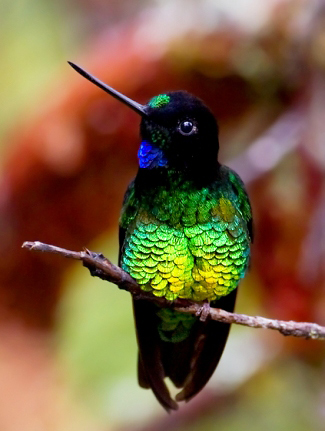
The brilliant Dusky Starfrontlet in the Colibri de Sol Nature Reserve by Dubi Shapiro.
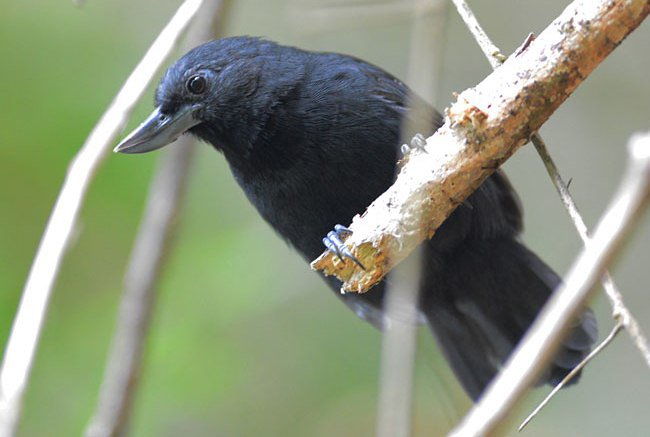
A rare image of a male Recurve-billed Bushbird near Bucaramanga by Paul Noakes.
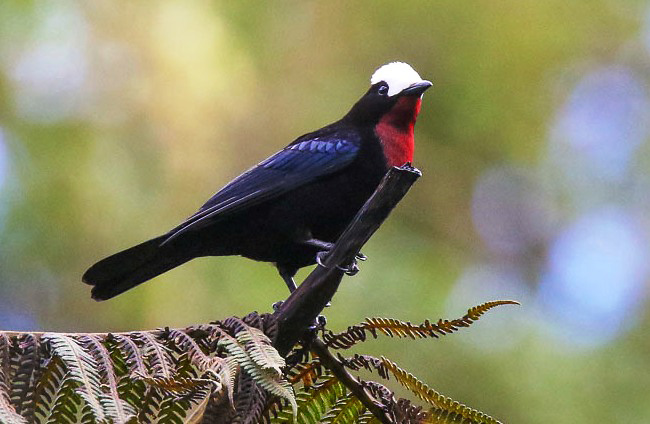
A superb White-capped Tanager at Rio Blanco by Brian Field.
- Choco
- Montezuma Lodge, at edge of Tatama NP Toucan Barbet, Bicolored Antvireo, Yellow-breasted Antpitta, Tatama Tapaculo, Beautiful Jay, Munchique Wood-wren, Black Solitaire, Choco Vireo, Black-and-gold, Gold-ringed, Purplish-mantled and Scarlet-and-white Tanagers, Crested Ant-tanager and Tanager Finch, as well as Violet-tailed Sylph, Booted Racket-tail, Purple-bibbed Whitetip, Brown Inca, Empress Brilliant, Purple-throated Woodstar, Velvet-purple Coronet, White-tipped Sicklebill, Lanceolated Monklet, Star-chested Treerunner, Parker's Antbird, Rufous Antpitta, Chestnut-crowned Gnateater, Purple-throated Fruitcrow, Orange-breasted and Scaled Fruiteaters, Olivaceous Piha, Club-winged Manakin, Glistening-green, Golden-chested, Grey-and-gold, Ochre-breasted and Rufous-throated Tanagers, Black-chinned Mountain-tanager, Chestnut-breasted and Yellow-collared Chlorophonias, and Chestnut-bellied and Indigo Flowerpiercers. Also a chance of Blackish Rail (at marsh near Montezuma Eco Lodge), Chestnut Wood-quail, Hooded Pitta, and Spillman’s Tapaculo.
- Ecolodge El Almejal, El Valle area and Utria NP Magnificent Frigatebird, Grey-headed Chachalaca, Tiny Hawk, Brown Wood-rail (Utria), Uniform Crake (Utria), Grey-chested Dove, Dusky Pigeon (Utria), Great Green Macaw, Red-lored, Rose-faced and Saffron-headed (Utria) Parrots, Humboldt’s Sapphire (mangrove boardwalk, Utria), Sapphire-throated (Utria) and Tooth-billed Hummingbirds, Black-breasted and Pied Puffbirds, Spot-crowned Barbet, Chestnut-mandibled and Choco Toucans, Stripe-billed Aracari, Black-cheeked and Crimson-crested Woodpeckers, Western Woodhaunter (Utria), Black-striped and Spotted Woodcreepers, Dusky and Spotted Antbirds, Spot-crowned Antvireo (Utria), Pacific Antwren, Streak-chested Antpitta, Black-tipped and Blue Cotingas (both along El Valle Road), Blue-crowned (lek), Golden-collared and Red-capped (lek) Manakins, Sapayoa (Utria), White-ringed Flycatcher, Choco (Western) Sirystes, Pacific Flatbill, Sulphur-rumped Myiobius, Lesser Greenlet, Stripe-throated Wren, Blue-whiskered, Dusky-faced, Lemon-spectacled, Rufous-winged, Scarlet-and-white and Scarlet-browed Tanagers, Scarlet-thighed Dacnis, Baudo Oropendola and Geoffroy's Tamarin. Also a chance of Berlepsch’s and Choco Tinamous, Baudo Guan, Great Curassow, Rufous-fronted Wood-quail, Tawny-faced Quail, Plumbeous Hawk, Olive-backed Quail-dove, Yellow-eared Toucanet, Choco and Lita Woodpeckers, Great Jacamar, Purple-chested Hummingbird, White-tipped Sicklebill, Thicket Antpitta, Pacific Royal Flycatcher, and an outside chance of Ocellated Antbird and Rufous-crowned Pittasoma.
Best Times for Birds and other wildlife in Colombia
The best times to visit are from December to February (the driest season) and from June to mid-September (another relatively dry period). During the wet seasons some roads may be closed due to landslides and so on.
Recommended Bird Books etc. for Colombia
Birds of Colombia by Steven L Hilty. Lynx Edicions, 2021.
Field Guide to the Birds of Colombia by M McMullan et al. Rey Naranjo Editores, 2018 (Third Edition).
A Guide to the Birds of Colombia by S Hilty and W L Brown. PUP, 1986.
Birds of South America: Non-Passerines: Rheas to Woodpeckers by F Erize, J R Mata and M Rumboll. PUP, 2007.
Birds of South America: Passerines by R S Ridgely and G Tudor. University of Texas Press/Helm, 2009 (Updated paperback edition of books listed next with 400 more illustrations).
The Birds of South America: Passerines by R S Ridgely and G Tudor. University of Texas Press, 1989 and 1994 (two volumes).
Birds of Northern South America by R Restall, C Rodner and M Lentino. Helm, 2006 (Two volumes).
Mammals of South America by R D Lord. Johns Hopkins University Press, 2007.
Neotropical Rainforest Mammals by L H Emmons. University of Chicago Press, 1997.
Butterflies of South America by B D’Abrera. Hill House, 1984.
Apps etc.
All Birds Colombia by Bloomsbury/Sunbird Images.
Where to watch birds in South America by N Wheatley. Helm, 1994.
Don’t know which country/countries to visit in South America? Then it may be worth considering taking a look at this book, written by this website’s author. It is many years old of course but it still provides a starting point, an overview and a guiding light to the best birds and the best places to look for them on the continent, and could save hours of searching for similar information on the internet. However, it is important to check more up-to-date sources for sites which have been opened up, sites and species which have been discovered, lodges that have been built etc. since the book was published.
Birding and Wildlife Trip Reports for Colombia
Many trip reports, some for Colombia, are posted on the websites listed here. On some of these websites some reports are independent and some are posted by tour companies who organize tours to Colombia. These tour companies and others also post their own reports on their websites, which are listed under 'Some Organized Tours to Colombia' below.
- The best website for trip reports is CloudBirders
- but these are also worth a look
- Birdtours
- Fatbirder
- Jon Hornbuckle
- Mammal Watching
Local bird and wildlife guides in Colombia
The costs of organized tours partly reflect the quality of the tour leaders. Some leaders are certainly better than others and many companies claim their leaders are the best but even the best rely at least to some extent on the exceptional skills of the local guides they employ. If you are travelling independently, employing such local guides will greatly increase your chances of seeing the wildlife you wish to see.
Accommodation for birders in Colombia
Some Organized Tours for birds and other wildlife to Colombia
There are many tour companies who organize tours to see mammals, birds, other wildlife and other natural wonders. The cost of these tours vary considerably according to such variables as the airlines used, the number of days the tours last, the number of sites visited, the number of people in the group (an important consideration if you wish to see such wildlife as rainforest mammals and birds), the number of tour leaders, the standard of accommodation and transport, and the percentage profit the company hopes to make. Generally, where the number of days tours last and the number of sites visited are similar, the cheapest tours are those that use the cheapest airlines, accommodation and local transport, that have the largest groups with the least number of leaders, and that make the least amount of profit. The most expensive tours tend to be those which are exceptionally long, use the most expensive accommodation (ridiculously lavish in some cases, even for single nights) and which make the most profit. Some tour costs partly reflect the quality of the tour leaders. Some leaders are certainly better than others and many companies claim their leaders are the best but even the best rely at least to some extent on the exceptional skills of the local guides they employ.
While tour companies organize tours with set itineraries many also organize custom tours for individuals and private groups who instead of taking a tour with a set itinerary want to follow their own itinerary to suit their own personal tastes, whether it be mammals, birds, other wildlife, other natural wonders or even man-made attractions, or a mixture of them all. Many organized tours with set itineraries are also fast-paced and target as many species as possible, whether they are mammals, birds or other wildlife or everything, which usually leaves little time to enjoy the best sites and individual species, but on a custom tour those taking part can specify the pace and the sites and species they wish to concentrate on. Custom tours also suit people who like to travel with people they already know, rather than with a group of strangers, and people with partners with different interests. Individuals and small groups will almost certainly have to pay more than the price of an organized tour with a set itinerary but a large group of friends may be able to travel for less than the price quoted for a set tour.
Tour companies who are running organized tours to Colombia in the next couple of years include the following. Many of these also offer custom tours.
